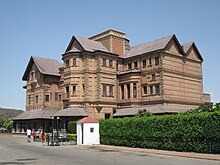Amar Mahal
The Amar Mahal is a palace in Jammu , in the Indian Union Territory of Jammu and Kashmir , which now serves as a museum. It was built in the 19th century for Raja Amar Singh by a French architect based on the model of a French chateau . The palace was donated to the non-profit Hari-Tara Trust by Karan Singh as a museum . The museum's numerous exhibits include a 120 kg throne, paintings and a library with 25,000 books.
The palace was the last official residence of the Dogra dynasty. A large number of portraits of the rulers of this dynasty are in the museum.
location
The Amar Mahal is located on the right bank of the Tawi , at an arch of the river in Jammu. In the immediate vicinity is the Hari Niwas Palace , which has been converted into a hotel
history
The Amar Mahal was planned by a French architect in 1862 but was not built until the 1890s. Maharani Tara Devi, wife of Maharaja Hari Singh lived in the palace until her death in 1967. After that, her son Karan Singh and his wife Yasho Rajya Lakshmi converted the palace into a museum.
The museum was inaugurated by Indira Gandhi on April 13, 1975. Guided tours, book readings, lectures and film screenings take place in the museum. Events for scholarly exchange and exhibitions are also regularly offered. Many of the miniatures in the museum were created in the second half of the 18th century in Jammu and Himachal Pradesh by the painters of the Kangra school. According to Karan Singh, they should abduct the visitor into their own world.
architecture
The palace was built of red sandstone with red bricks on a hill above the Tawi. Built in the style of a European castle , the palace has curved roofs with battlements and towers. During construction, it was the tallest building in Jammu. The building has covered walkways on three sides. The passageways are supported by columns and a wooden framework. The first floor of the building has floor-to-ceiling windows with a wraparound balcony. The top floor has bay windows. The windows also have classical Greek style protrusions over ornamental columns.
exhibition
Only four rooms of the palace are open. They show pictures from the Mahabharata and souvenirs of the princely family. A golden sofa, the throne of the Dogra rulers, that weighs 120 kg and is made of pure gold, is exhibited in a hexagonal room and can be viewed through a pane of glass. Works of art by Indian artists such as MF Hussain , J.Swaminathan, GR Santosh, Bikash Battacharjee, Ram Kumar, Laxman Pai can also be seen in the museum. 47 pictures from the Hindu epic Nala and Damayanti are shown. Modern paintings of the ten avatars of the Hindu god Vishnu are exhibited in a special room of the museum. Portraits of the families of the Dogra rulers of Jammu and Kashmir are shown in the entrance hall. On the first and second floors is the library with a collection of rare old books on religion, philosophy, political science, and popular literature.
One room in the museum used to be a room of the Maharani Tara Devi and has been preserved in its original state. A silver bedspread, furniture and photos are shown. Also on display are an Indian crown given to her in 1945 and clothing items, as well as the Victorian bathroom.
Individual evidence
- ↑ a b c d e Amar Mahal Palace Museum ( Memento from March 23, 2010 in the Internet Archive )
- ↑ a b c Robert Bradnock, Roma Bradnock: Indian Himalaya handbook. The travel guide (= footprint handbooks ). Footprint, Bath 2000, ISBN 1-900949-79-2 .
- ↑ Amar Mahal Palace Museum ( Memento from March 5, 2012 in the Internet Archive )
- ^ Sarina Singh: Lonely Planet India . Lonely Planet, Footscray, Vic. / Oakland, CA 2007, ISBN 978-1-74104-308-2 , pp. 364 .
- ^ Amar Mahal Museum and Library. ( Memento of the original from December 23, 2009 in the Internet Archive ) Info: The archive link was automatically inserted and not yet checked. Please check the original and archive link according to the instructions and then remove this notice.
- ^ Kishor Gandhi, Karan Singh: The Transition to a global society. Allied Publishers, New Delhi 1991, ISBN 81-7023-320-8 , p. 251.
- ↑ in the museum
- ↑ Desh Bandhu: Jammu Kashmir and Ladakh. Tourist-attractions & tourism . Akashdeep Pub. House, Delhi 1989, ISBN 81-7158-014-9 , pp. 82 .
- ↑ a b c Jammu - Sight Seeing Guide: Jammu: Amar Mahal Palace. on jammu.com.
- ↑ a b Amar Mahal Museum ( Memento from April 20, 2006 in the Internet Archive )
Coordinates: 32 ° 44 ′ 52.8 " N , 74 ° 52 ′ 19.2" E
